
It’s important to understand the different change management models available.
Why?
For your business to survive, it will need to evolve. For it to evolve, you need to make changes. Without a change management model, the success of those changes is up to nothing more than hope and dumb luck.
I’ve already gone over how to form your own change management strategy, so for this post, I’ll outline everything you need to know about 8 proven change management models that will put your organization at the top of the food chain:
- Lewin’s change management model
- The McKinsey 7-S model
- Kotter’s theory: Coaching people through change
- The “Nudge” theory of change management
- The 5 goals ADKAR for successful change management
- Bridges’ transition model
- Kübler-Ross’ change curve
- The Satir change management model
Let’s get started!
Lewin’s change management models
Lewin’s model is one of the most popular approaches, and it’s easy to see why. By splitting the change process into three stages you can break a large, unwieldy shift into bitesize chunks which account for both the processes and people in your company.
Lewin describes three stages of change management:
- Unfreeze
- Make changes
- Refreeze
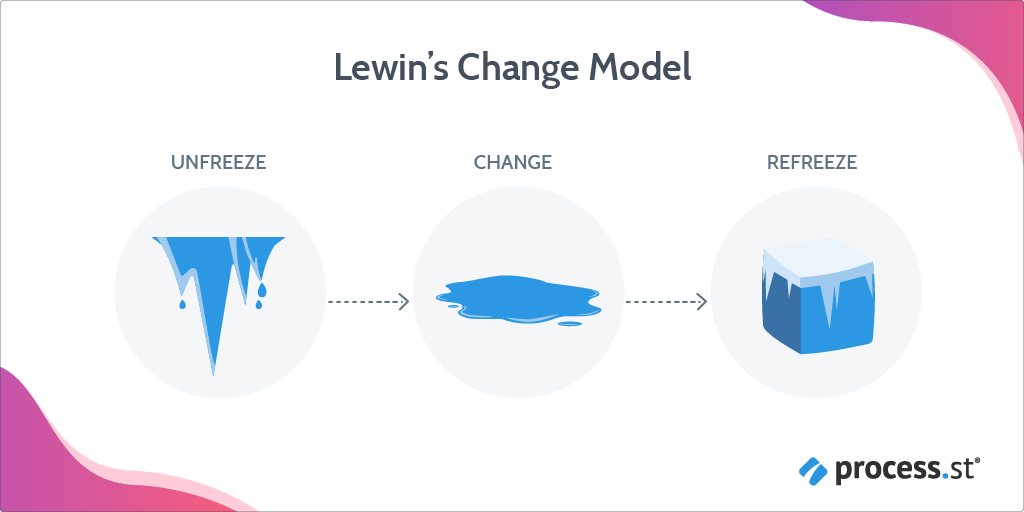
Unfreeze your process and perceptions
“Unfreezing” means analyzing every step of your process to look for potential improvements. It also applies to your organization’s perception of the process, potential changes, and any resistance that might pop up.
By doing this you’re helping to eliminate any existing bias and commonly accepted mistakes. This gives you the perspective you need to change the cause of your problems, rather than just the symptoms.
Make your changes

“Learning is more effective when it’s an active rather than a passive process.” – Kurt Lewin
Once you’ve prepared everyone, it’s time to deploy your changes and guide the team as they adapt.
For this step to be successful, you need to focus on three vital areas:
- Education: Make sure you provide adequate training for all new systems and technology your employees will need to use.
- Support: This could be a manager, mentor, or even simply a knowledge base they can access for more information.
- Communication: Maintain open channels of communication – both so employees know what to expect and provide feedback on progress and roadblocks.
Refreeze the new status quo
Once your changes have been deployed, measured, and tweaked according to feedback, you need to “refreeze” your new status quo. This is vital to any change management model – everything you’ve done is pointless if old habits resurface.
If you’ve listened to (and applied) feedback then this stage will be a little easier, since your employees will be more invested in the changes.
Your work isn’t finished, though. You still need to conduct regular reviews to make sure the new methods are being followed, are effective, and whether or not they need to be updated again. It can take time for new policies to become a habit, so continuously check in on how your employees are handling the change.
Lewin’s Change Management Model Process Checklist
Click here to access Lewin’s Change Management Model Process Checklist!
The McKinsey 7-S change management models
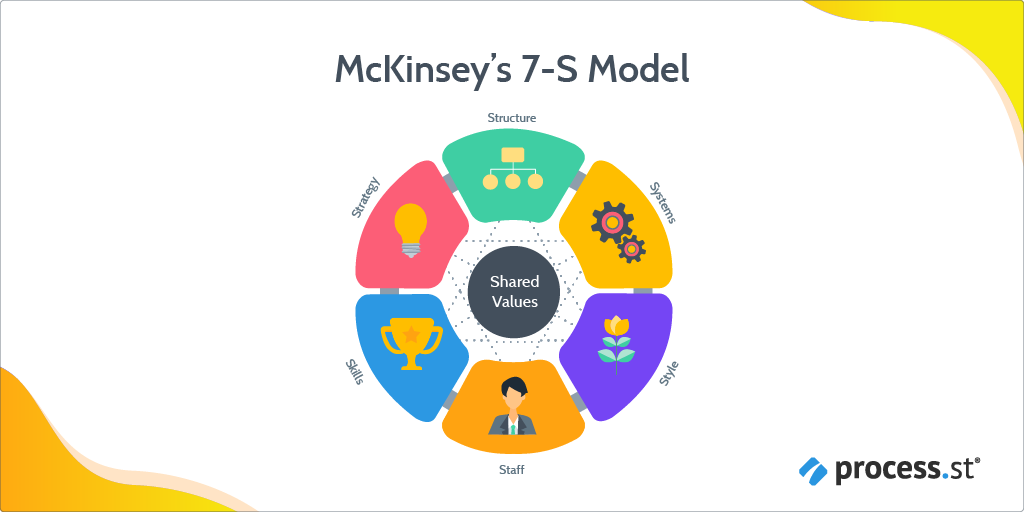
The McKinsey 7-S model is great for analyzing how coherent your company is. If you know that you need to change your act, but you’re not sure what to do, this is the change management model for you.
By analyzing the following seven aspects of your company and how they affect each other, you will highlight the changes you need to make to create a united approach to business:
- Strategy
- Structure
- Systems
- Shared values
- Style
- Staff
- Skills
By analyzing each of these seven aspects, you’ll gain a clear picture of how they apply to your organization and how they relate to each other. Every aspect needs to support the other six. If you find one that doesn’t, that’s the area you need to look at for potential improvements.
⏩ Click here for a preview of the McKinsey 7-S Change Management Model Checklist Proce workflow
Click here to add this workflow to your free Process Street account!
Kotter’s theory: Coaching people through change
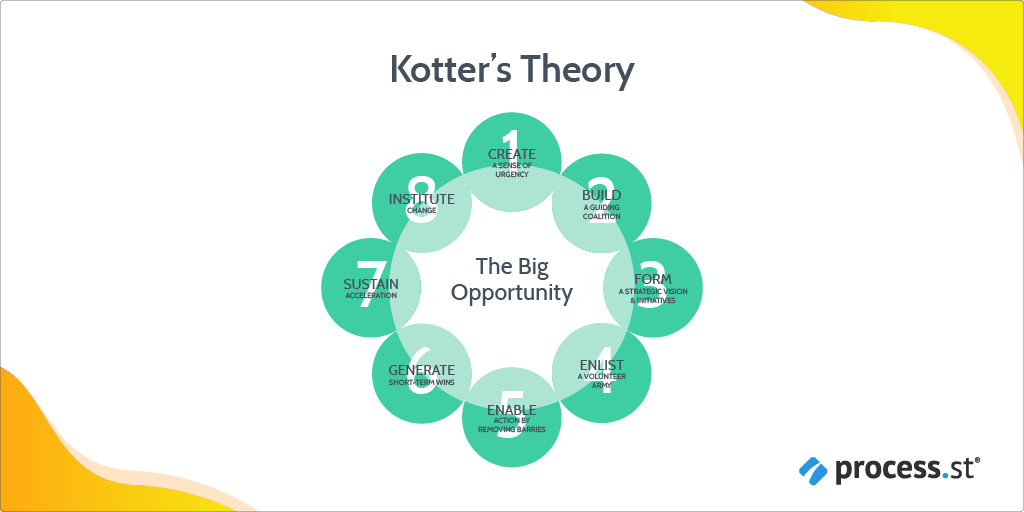
Kotter’s theory is the first in this list to focus less on the change itself and more on the people behind it (albeit from a top-down point of view). By inspiring a sense of urgency for change and maintaining that momentum, Kotter’s theory can be used to great effect in adapting your business to the current climate.

“Leaders establish the vision for the future and set the strategy for getting there.” – Dr. John Kotter
Kotter’s theory works by:
- Creating a sense of urgency
- Building a core coalition
- Forming a strategic vision
- Getting everyone on board
- Removing barriers and reducing friction
- Generating short-term wins
- Sustaining acceleration
- Setting the changes in stone
⏩ Click here for a preview of Kotter’s Change Management Process Checklist workflow
Click here to add this workflow to your free Process Street account!
The “Nudge” theory of change management
Nudge theory is more of a mindset than a set of change management models. The basic theory is that “nudging” change along is much more effective than trying to enforce it in a traditional sense.
According to Businessballs, effective nudges are:
- Indirect
- Subtle
- Open-ended
- Educational
- Backed up with evidence
- Optional
- open to discussion
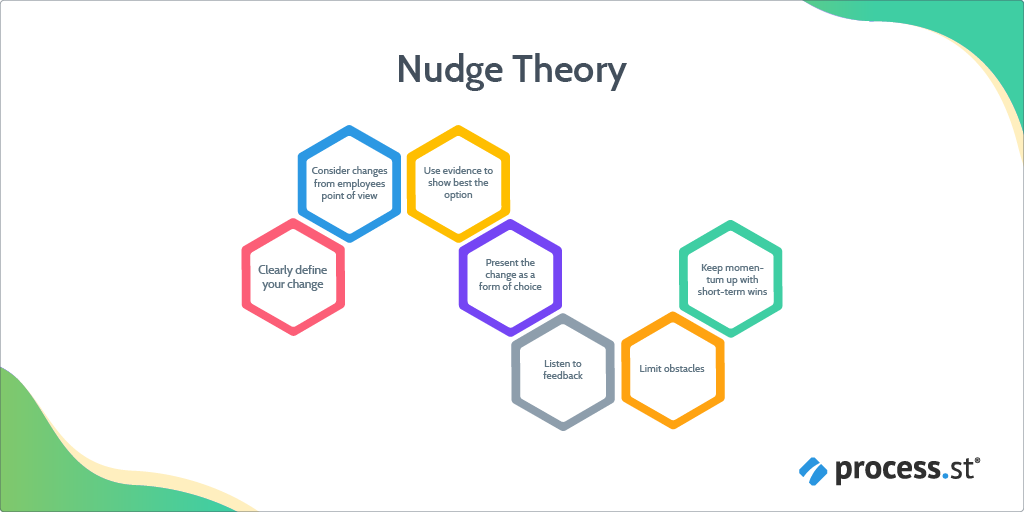
The basic principles you need to follow when nudging changes are:
- Clearly define your changes
- Consider changes from your employees’ point of view
- Use evidence to show the best option
- Present the change as a choice
- Listen to feedback
- Limit obstacles
- Keep momentum up with short-term wins
⏩ Click here for a preview of the Nudge Theory Change Management Model Checklist
Click here to add this workflow to your free Process Street account!
The 5 goals ADKAR as successful change management models
Created by Jeffery Hiatt (founder of Prosci), the ADKAR change management model is a bottom-up method that focuses on the individuals behind the change. Rather than being a sequential method, ADKAR is a set of goals to reach (with each letter of the acronym representing one of these goals).
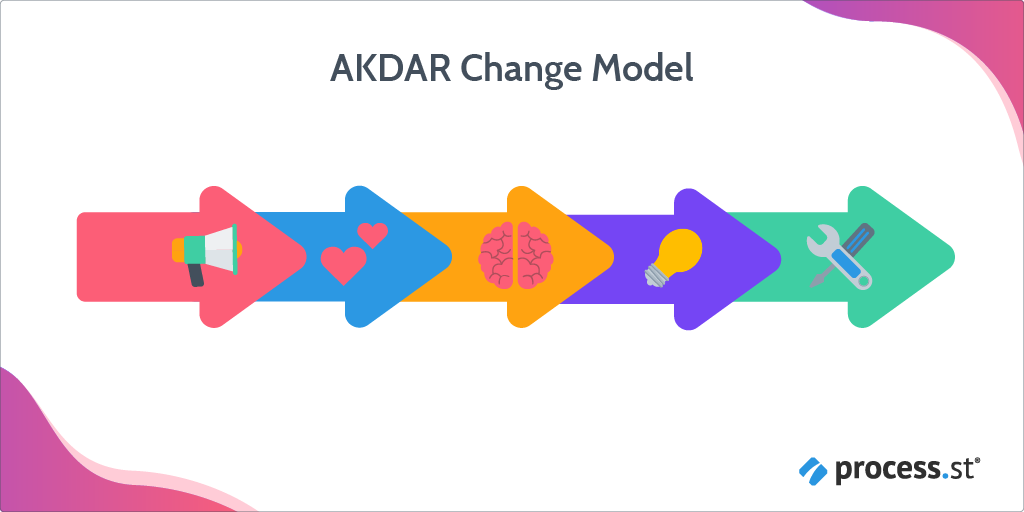
By focusing on achieving the following five goals, the ADKAR model can be used to effectively plan out change on both an individual and organizational level:
- Awareness (of the need to change): Your employees need to understand why the change is happening, but this step isn’t about simply dictating what they need to do. Use evidence to back up your plan and convince them the change is positive.
- Desire (to participate and support the change): Awareness is good, but it’s nothing if people don’t want to change. This will be a true test of your skills as a leader since you will literally need to win the hearts and minds of your employees.
- Knowledge (on how to change): Make sure everyone knows what their role in the change will be. People dislike change because of the uncertainty; a clear plan of the steps, expected results, and parts they need to play will help alleviate some of that anxiety.
- Ability (to implement required skills and behaviors): Knowing what needs to be done is just one side of the coin. Employees may need extra training or coaching in order to fulfill their responsibilities. Again, if people feel prepared and confident in their abilities to handle change, they are less likely to resist it.
- Reinforcement (to sustain the change): After you’ve done the heavy lifting, you need the change to stick. Performing regular reviews and offering incentives are great ways to help employees establish new habits and provide accountability (for you, too).
⏩ Click here for a preview of the ADKAR Model Change Management Process workflow
Click here to add this workflow to your free Process Street account!
Bridges’ transition model
Created in 1991 by William Bridges, this change management model focuses on transition rather than change. While that might seem pedantic, it alters the entire way that change management is approached.

“Nothing so undermines organizational change as the failure to think through the losses people face.” – William Bridges
I mentioned earlier that the uncertainty of change causes anxiety; as a result, change can often feel intrusive. People perceive it as happening to them rather than something they’re actively involved in.
A transition, on the other hand, implies a gradual adjustment. It’s a planned journal rather than a radical shift. This approach allows employees to process the emotions they feel about the change and feel more prepared for any new expectations of them.
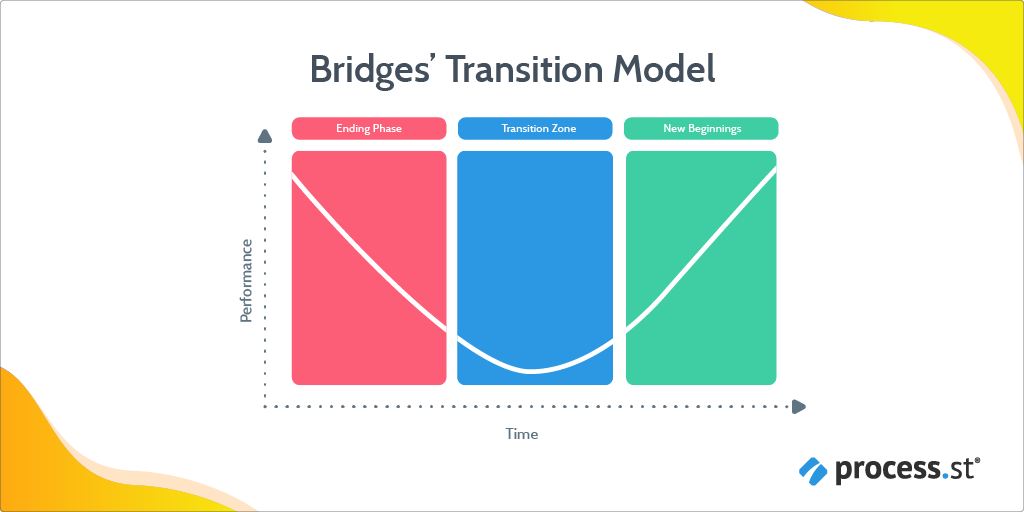
It does this by detailing three stages of transition, each of which the employee must be guided through for the change to be successful:
- Ending, losing, and letting go: Focus on listening and communicating. Your employees’ will likely feel very vulnerable at this stage and will rely on you for a sense of stability and reassurance. Be clear about what they can expect and assure them they will be supported throughout the transition.
- The neutral zone: “Neutral” is potentially misleading here. This stage involves all the hard work required to make the transition, but without experiencing any of the benefits yet. Persevering here is crucial to your success since this is the stage where many people get discouraged, give up, or impede the process.
- The new beginning: Give everyone some kudos and a little celebration here, but like all the other models, your work is not quite finished. This stage requires vigilance and reinforcement. Capitalize on the high energy of this stage to cement your changes as the new status quo.
⏩ Click here for a preview of Bridges Transition Model Process Checklist workflow
Click here to add this workflow to your free Process Street account!
The Kübler-Ross change curve
Elisabeth Kübler-Ross was a psychiatrist who detailed the five stages of grief in her book, On Death & Dying. It may seem odd to talk about grief in terms of a change management model, but it actually makes a lot of sense.
Grief isn’t always a dramatic event. Think about the last time a favorite product was discontinued or an app updated its UI. Your response likely followed the Kübler-Ross model of the stages of grief – albeit probably on a much more subtle level.
Change always requires a loss of some sort, and your employees will have an emotional reaction to that loss. Understanding how people process those emotions will enable you to prepare your response in advance.
The five stages of the are: Kübler-Ross change curve are:
- Denial
- Anger
- Bargaining
- Depression
- Acceptance
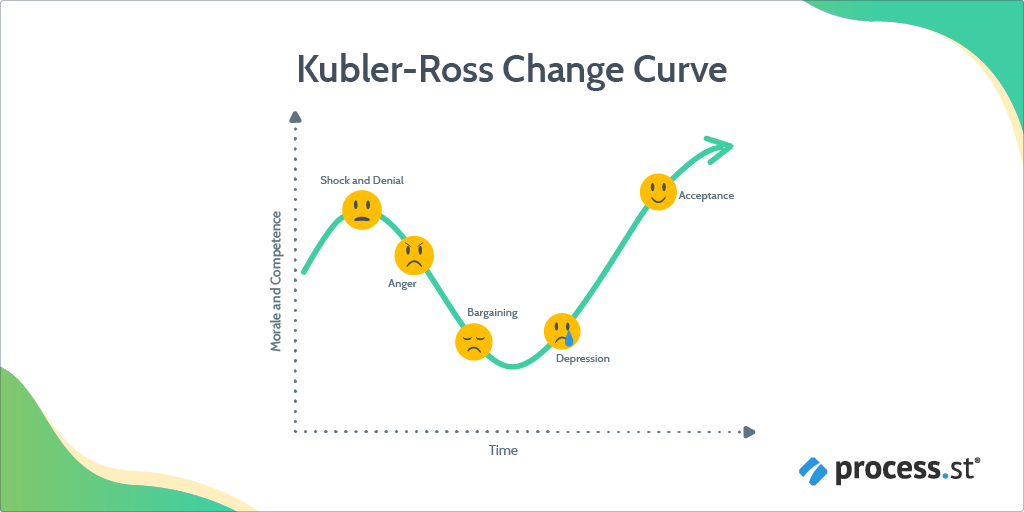
If you’re still not convinced this model can help, let’s go back to the updated app.
- The update is released and users respond with surprise, shock, theories it may be a glitch or some other temporary change.
- Some very vocal users take to social media to protest the change and criticize the company for making such obvious mistakes with the new UI.
- These angry users will lodge complaints and/or start petitions in the hopes of pressuring the company to revert to the old setup.
- When the company doesn’t respond – or refuses to undo the update – those previously angry users experience a sort of sadness and rejection. Their much-loved app isn’t the same anymore and the company they were so loyal to doesn’t seem to care about their users’ feelings.
- While typically continuing to use the app throughout this process, those same users have slowly gotten used to the new UI. Some may realize the changes have actually improved their experience, others may simply adjust to the new layout. Either way, the updated UI has been accepted.
(It’s quickly worth noting that people can move through the stages in a random order, and they can jump backward or repeat stages, too.)
⏩ Click here for a preview of the Kübler-Ross Change Curve Process Checklist workflow
Click here to add this workflow to your free Process Street account!
The Satir change management models
The Satir change model is similar in some ways to the Kübler-Ross curve, but it focuses more on performance during the change. In this sense, it’s a way of predicting and tracking the effect of changes on overall performance.
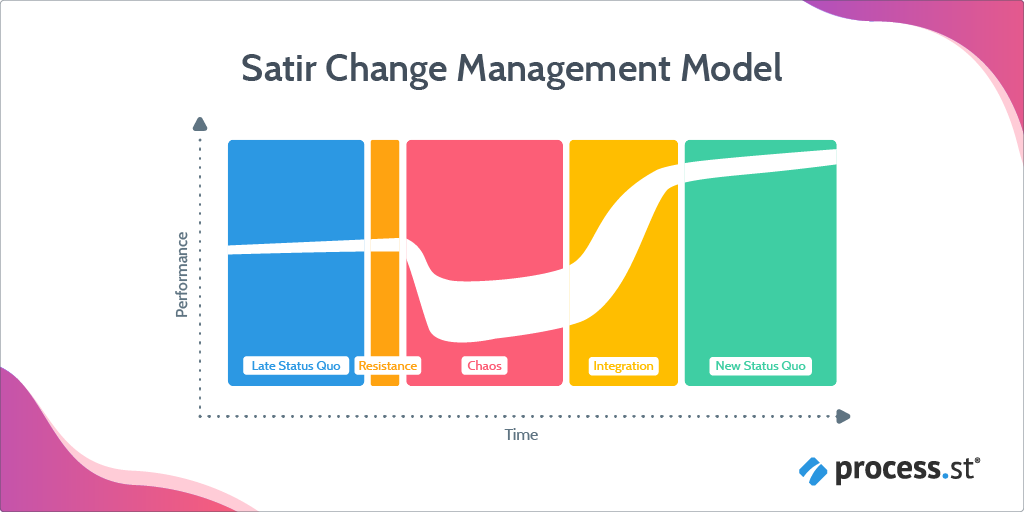
Satir’s change management model is made up of five stages:
- Late Status Quo
- Resistance
- Chaos
- Integration
- New Status Quo
Also, before diving into the final change management model, note that the Satir model focuses on tracking rather than affecting performance. Without using a supporting model to tackle these negative effects, you’re left with little more than a way to measure the effect of your change.
This isn’t always a bad thing, but keep it in mind when looking for a method to actively support your changes.
Unlike most other change management models, the Satir model also provides an easy way to analyze the impact of your changes at a glance (by producing a graph based on your ongoing performance). Not only that, but it makes it easy to compare the effects of various changes you have made and provide a measure of your business’ progression.
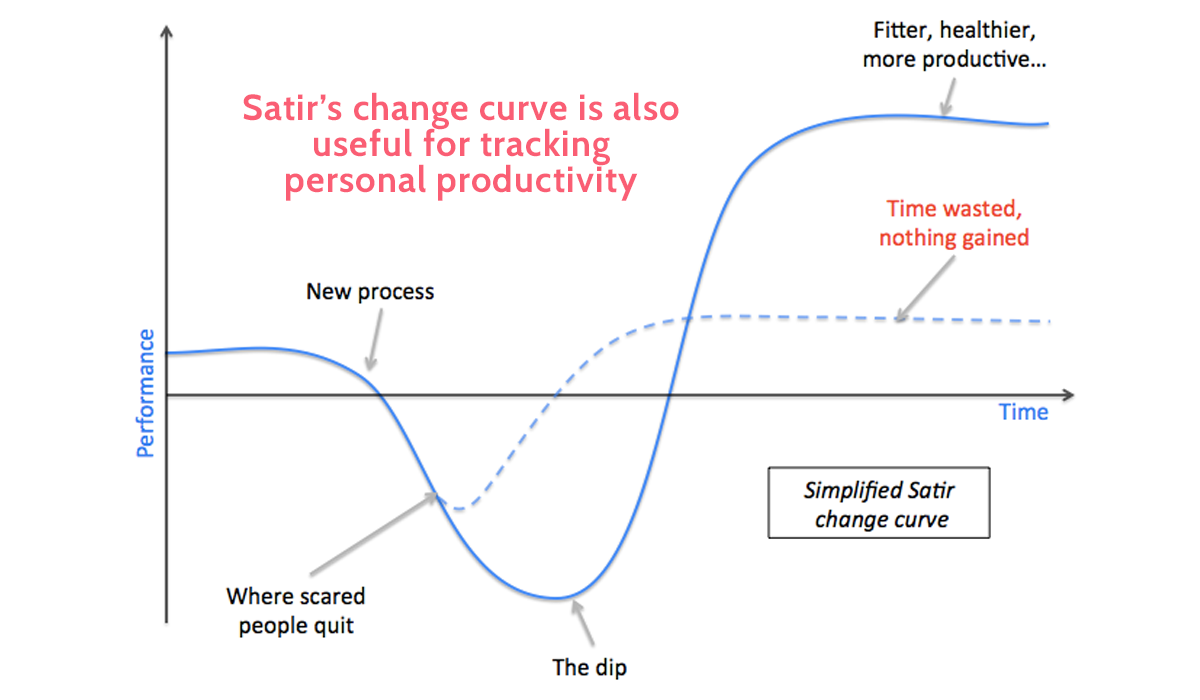
⏩ Click here for a preview of the Satir Change Management Model Process Checklist workflow
Click here to add this workflow to your free Process Street account!
Use Process Street to manage change in your business
Choosing the right change management model might seem overwhelming at first, but using a solid framework to deploy your changes is crucial to a business’ successful evolution. It’s also important to remain mindful of how these changes will impact your employees – and what their reactions might be as a result.
Using one or more of the change management models listed in this post will enable you to predict and prepare for your employees’ concerns, giving your company the best chance to not just survive, but thrive in the corporate wild.
The included workflow templates will get you off on the right foot but walking you through every step of the change management process. You can proceed with the confidence that no element will fall through the cracks, even if you’ve never used a particular change management model before.
Process Street workflows incorporate a variety of dynamic features that make all our workflows intuitive and easy to use. Plus, they offer the added bonus of documenting your process every time you use it so you have a record of what’s been done before.
It’s a good idea to establish a thorough risk management plan as part of your change management process. That way, you can ensure you’re well-prepared for any complication so implementing your changes runs smoothly.
Process Street can help you with that.
How do you deploy changes within your own organization? I’d love to hear from you in the comments below!







 Workflows
Workflows Forms
Forms Data Sets
Data Sets Pages
Pages Process AI
Process AI Automations
Automations Analytics
Analytics Apps
Apps Integrations
Integrations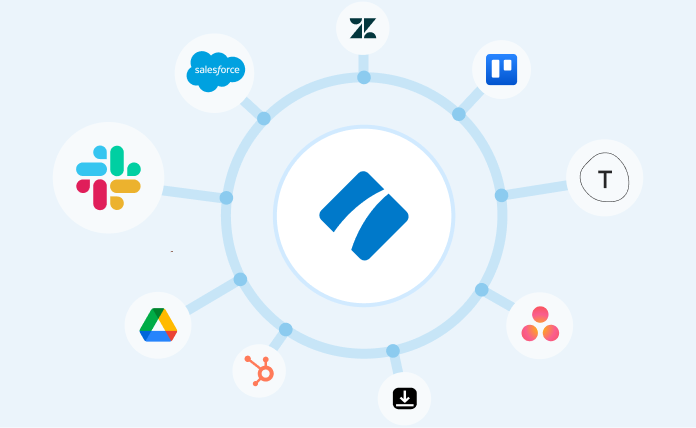
 Property management
Property management
 Human resources
Human resources
 Customer management
Customer management
 Information technology
Information technology



Ben Mulholland
Ben Mulholland is an Editor at Process Street, and winds down with a casual article or two on Mulholland Writing. Find him on Twitter here.